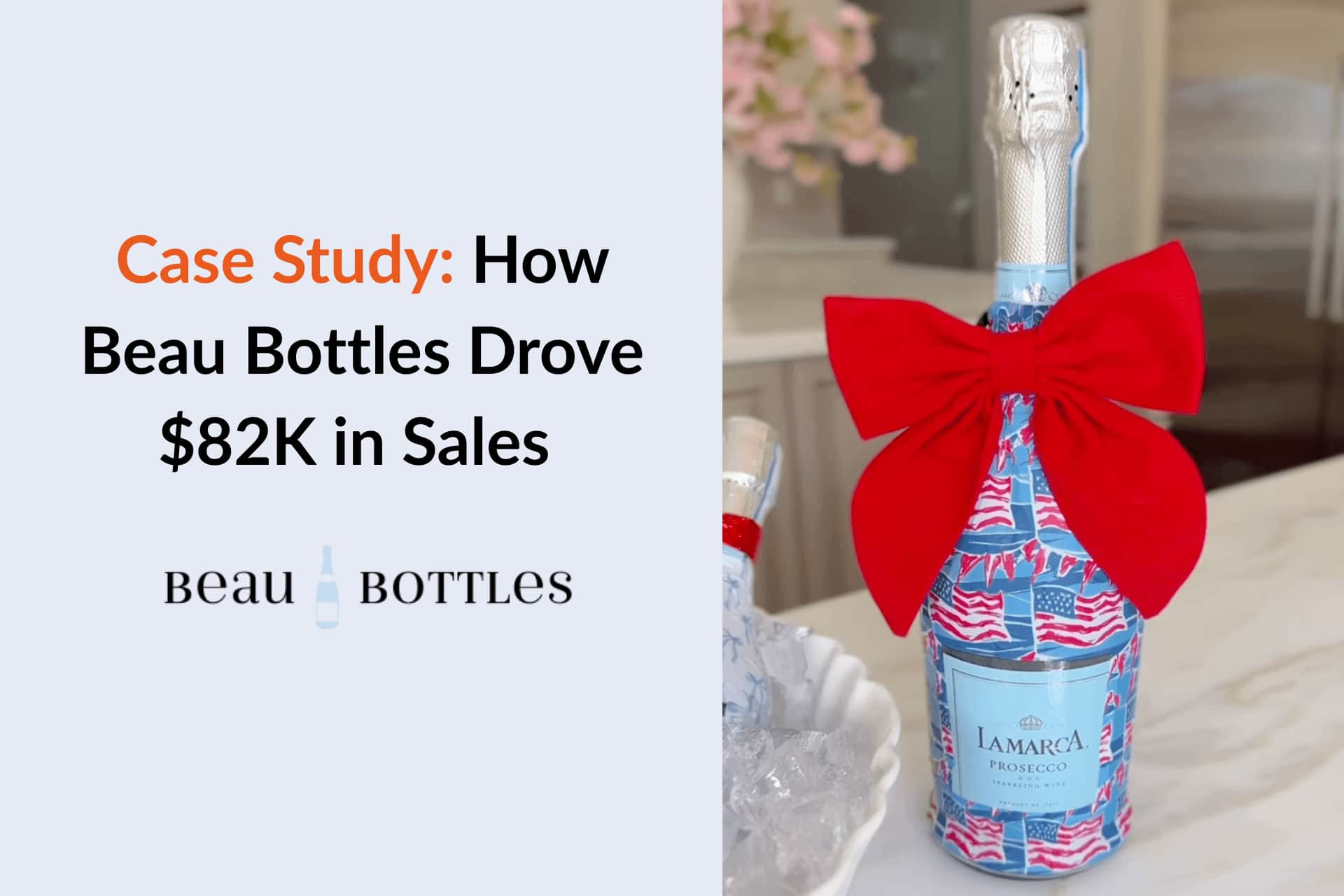





Platforms like TRIBE Group have played a key role in connecting brands with creators, but marketers often encounter limitations such as repetitive creator pools that limit campaign diversity, inconsistent engagement quality on sponsored content, and a rigid workflow that requires heavy reliance on support teams. These challenges have led many businesses to actively search for more flexible and scalable alternatives that provide greater efficiency and transparency.
In this article, we’ll take a closer look at the Top 10 TRIBE Alternatives, giving you a comprehensive comparison to help you find the best fit for your marketing needs.
While TRIBE offers a streamlined approach to influencer and content marketing, there are several recurring limitations that make many businesses explore alternative platforms. Below are four key pain points frequently highlighted in reviews and analysis.
Campaigns often attract the same group of creators repeatedly, resulting in a limited variety of voices and perspectives. This lack of diversity can make it harder for brands to reach new audience segments or keep campaigns fresh.
Another recurring concern is the quality of content and engagement rates. Even when creators have large follower counts, the interaction on sponsored posts can be low, with some accounts showing inauthentic activity patterns that reduce campaign impact.
The platform’s workflow can feel restrictive when operating independently. Without engaging a support or account manager, flexibility during campaign setup and execution is limited, which can slow down teams that need more agile management.
TRIBE remains web-only, without a dedicated mobile app. In addition, core functions such as monetization require third-party integrations, which often come at extra cost and add complexity to campaign management.
Our comparison focuses on several key aspects:
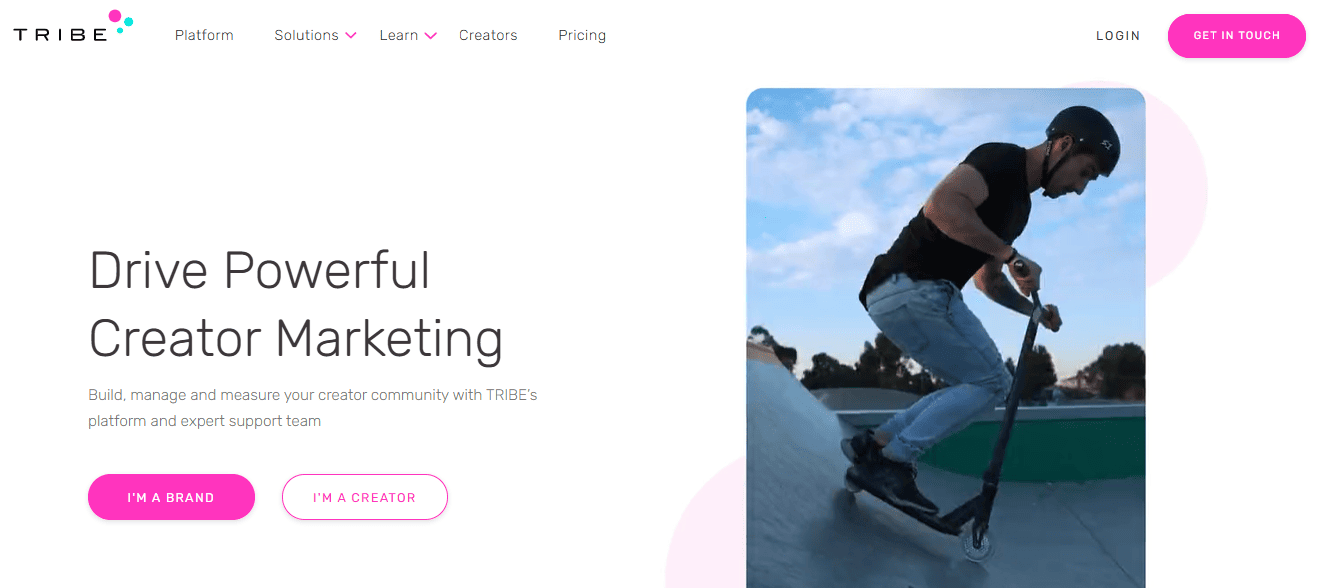
Best For: TRIBE is best suited for brands and agencies looking to streamline influencer campaigns by leveraging a large creator pool, with strong support for user-generated content (UGC) licensing and campaign performance tracking. It works particularly well for businesses seeking quick execution of trend-driven strategies.
Platform Coverage:
Pricing: Pricing is typically annual or campaign-based; region-specific variations apply.
For example: On a $10,000 campaign, $7,000 goes to creators and $3,000 to TRIBE as platform fees (30%).
Reviews: 4.6 /5.0 (G2)
Ease of Use (UX/UI): TRIBE is often described as intuitive and user-friendly, with a clean dashboard and well-structured campaign tools that simplify the influencer selection and approval process. Many marketers highlight its efficiency in bringing multiple campaign functions—briefing, approvals, payments, and reporting—into a single hub. However, the mobile experience is less polished, which can hinder campaign management on the go.
Customer Support: The platform provides strong customer support via a dedicated Customer Success team available across all plans. Users benefit from campaign guidance, analytics support, and help with negotiations. In addition, TRIBE maintains a comprehensive Help Center with FAQs, case studies, and legal/payment documentation to resolve common queries efficiently.
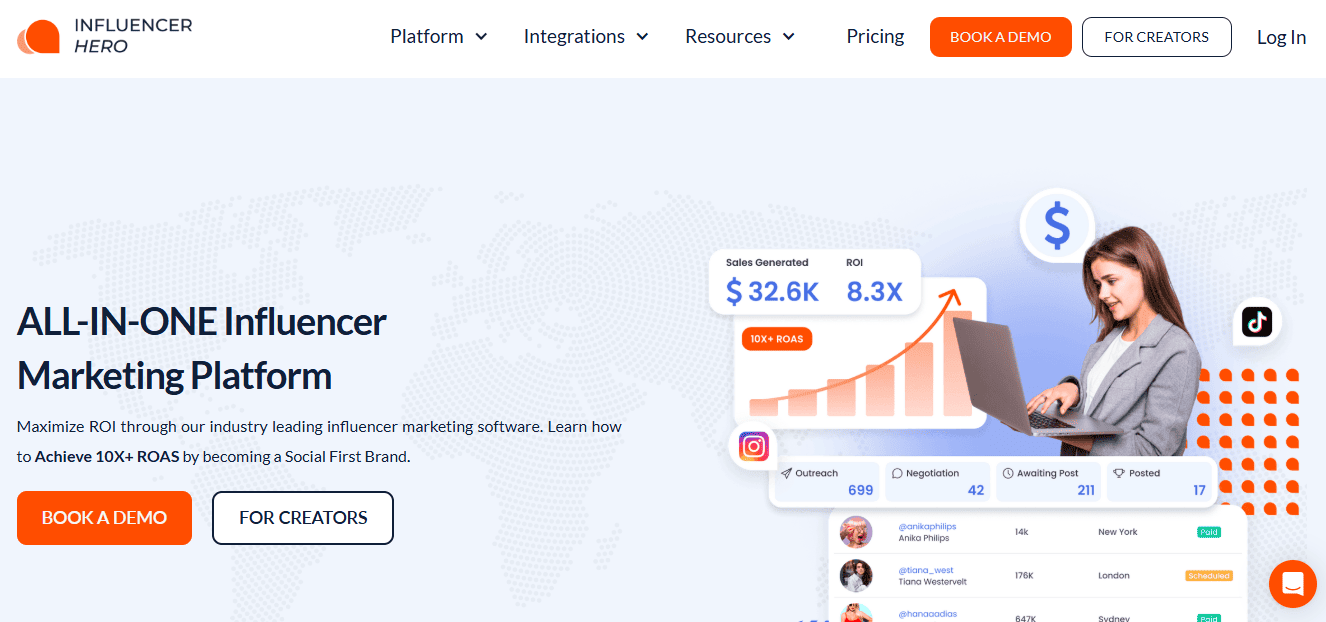
Best For: Growing D2C brands and eCommerce teams on Shopify, WooCommerce, or custom setups looking to scale influencer and affiliate marketing campaigns with automation, multi-platform support, and ROI-driven insights.
Platform Coverage:
Pricing: Influencer Hero offers flexible pricing plans to accommodate growing brands. All plans include core features and can scale as the influencer program grows.
Reviews: 5.0 / 5.0 (Capterra)
Ease of Use (UX/UI): Influencer Hero is known for its intuitive design and clean dashboard. Brands benefit from drag-and-drop campaign setup, automated workflows, and customizable email templates, allowing even non-technical teams to get up and running in under an hour.
Customer Support: Customer support is one of Influencer Hero’s strongest advantages. Every plan comes with a dedicated account manager from day one. Brands also get 24/7 real-human live chat, responsive email support, onboarding sessions, and a robust help desk with how-to guides and tutorials. Pro plan users also enjoy access to a private Slack channel for continuous, real-time support and optional strategy consultations.
While TRIBE focuses primarily on content marketplaces where brands source UGC from influencers, Influencer Hero delivers a far more comprehensive all-in-one influencer marketing suite. Influencer Hero combines discovery, outreach, CRM, analytics, and gifting into a single platform—giving brands full control over every stage of a campaign.
Pricing is another key difference. TRIBE charges per campaign or per post, which can become costly for scaling brands. In contrast, Influencer Hero’s flat monthly plans (starting at $649/month) allow unlimited campaigns and a larger creator pool, making it a more predictable and scalable solution.
For brands aiming to build long-term influencer relationships and leverage AI-powered automations across multiple platforms, Influencer Hero is the stronger choice. TRIBE remains useful for brands looking for one-off content, but Influencer Hero’s data-driven workflows and superior support give it the edge for sustainable growth.

Best For: Modash is best for eCommerce and DTC brands that want to scale influencer and affiliate marketing campaigns with reliable tools for discovery, tracking, and payouts. It’s also well-suited for marketing teams targeting multiple regions and niches thanks to its large creator pool and advanced filters.
Platform Coverage:
Pricing: There are different plans and options.
Reviews: 4.7/5 (G2)
Ease of Use (UX/UI): Users consistently highlight Modash’s straightforward interface and intuitive workflow, which makes influencer discovery and outreach quick to manage. The streamlined CRM-style dashboard allows teams to track creators, outreach status, and campaign performance in one place. Many note that while it offers advanced filters, the search and reporting tools remain accessible even for first-time users.
Customer Support: Modash is praised for excellent onboarding and responsive support, particularly during the early campaign setup phase. Their customer success team is known for offering hands-on guidance and best practices, helping brands optimize outreach lists and performance tracking. Support is available via chat and email, with timely responses and actionable recommendations.
While both TRIBE and Modash are strong influencer marketing platforms, they cater to slightly different brand needs. TRIBE focuses heavily on UGC campaigns and creative content submissions from influencers, where brands post briefs and creators pitch their work. This approach is great for campaign-based, content-first strategies, but can become costly due to creator pricing and less predictability in ROI.
Modash, on the other hand, emphasizes scale, automation, and performance tracking. With its 350M+ creator database, Shopify integration, and built-in affiliate automation, it appeals more to eCommerce brands seeking measurable ROI and long-term partnerships rather than one-off content campaigns.
Pricing also reflects this difference: while TRIBE’s campaigns are budget-flexible but creator-driven, Modash offers structured plans starting at $199/month, making it more predictable and cost-effective for teams wanting an all-in-one platform.

Best For: E-commerce brands on Shopify and Amazon looking to run large-scale influencer and affiliate campaigns with deep sales attribution and customer-to-creator conversion.
Platform Coverage:
Pricing:
Reviews: 4.5/5 (G2)
Ease of Use (UX/UI): Upfluence offers a comprehensive, feature-rich platform, which users describe as powerful but slightly complex at first. While the dashboard provides robust search, outreach, and campaign management in one place, new users may find the setup process time-consuming. Once familiar, the interface streamlines workflows effectively, particularly for eCommerce integrations.
Customer Support: Users note that Upfluence’s customer support team is responsive and helpful, with access to onboarding resources and account managers to guide setup. However, some feedback highlights that due to the platform’s complexity, support is most beneficial for mid-size to enterprise brands rather than smaller teams with limited resources.
While TRIBE is built around connecting brands directly with influencers for content collaborations, Upfluence delivers a much broader end-to-end influencer management system. TRIBE offers pay-per-campaign flexibility, whereas Upfluence requires an annual contract but includes influencer discovery, CRM, affiliate tracking, and payment tools in one package.
Pricing is a major distinction: TRIBE operates on a flexible, campaign-based pricing model where brands pay per collaboration, making it attractive for smaller businesses or those experimenting with influencer marketing. In contrast, Upfluence’s $1,276/month annual plan is a significant investment, best suited for scaling brands and established eCommerce companies looking for ROI-focused integrations with Shopify and Amazon.
Ultimately, brands looking for scalable, long-term influencer and affiliate programs with advanced tracking may prefer Upfluence, while those seeking quick, campaign-driven collaborations without long-term commitments may lean toward TRIBE.

Best For: Captiv8 is best for mid-market and enterprise teams that need deep discovery, competitive intelligence, and advanced performance reporting across multi-campaign programs—with the budget to support enterprise-style pricing and add-ons like creator storefronts/affiliate commerce.
Platform Coverage:
Pricing: There are different pricing options:
Reviews: 4.1/5 (G2)
Ease of Use (UX/UI): The workflow is built for collaboration: teams can approve/discard creators together, chat directly with creators, and discuss specific profiles inside the platform. Saved filter locking avoids rebuilding complex searches, while drag-and-drop metrics and public report links simplify reporting to stakeholders. The breadth of options can feel heavy for smaller teams and may require some ramp-up.
Customer Support: Materials emphasize enterprise deployments and managed options (e.g., storefronts/affiliate). However, the packet also references community posts alleging customer-service and payment issues on both brand and creator sides—something to clarify around SLAs and payouts during procurement.
TRIBE centers on an opt-in creator marketplace where brands post briefs and receive pitches, with the platform handling payments, approvals, and legal—plus options for licensing and media buying. Captiv8 is a data-forward platform emphasizing discovery at scale (15M+ creators), competitive tracking, and granular analytics with collaborative campaign tooling.
In terms of pricing, TRIBE charges activation fees + platform margins per campaign; Captiv8 requires an annual $25K contract + $3K onboarding, with $20–30K/month for Storefronts + Affiliate—more predictable but higher fixed spend.
Choose TRIBE for rapid content via creator pitches and licensing flexibility. Choose Captiv8 for research depth, competitive insights, advanced reporting, and always-on multi-campaign programs.

Best For: Enterprise-level brands and agencies managing large-scale influencer programs across multiple regions. Trusted by Fortune 500 companies like Disney, Coca-Cola, and Lululemon, CreatorIQ is best suited for organizations that need a full end-to-end influencer marketing solution with advanced reporting, payments, and CRM capabilities.
Platform Coverage:
Pricing: There are different plans:
Reviews: 4.7/5 (G2)
Ease of Use (UX/UI): Users highlight CreatorIQ’s professional and enterprise-grade interface, which offers a broad set of features without feeling cluttered. The platform provides intuitive dashboards, customizable reporting, and shareable live links, making it easier to communicate results across teams and stakeholders. However, due to the depth of functionality, onboarding and training are often required to unlock the full potential.
Customer Support: CreatorIQ offers strong hands-on support with dedicated implementation managers and customer success teams. Clients report that their support goes beyond troubleshooting—providing quarterly planning, campaign strategy, and early access to platform updates. This level of partnership is a differentiator for brands that want more than just software, but strategic guidance as well.
TRIBE vs CreatorIQ
TRIBE and CreatorIQ serve two very different segments of influencer marketing. TRIBE is built for speed and accessibility—allowing brands to launch creator campaigns quickly with minimal setup, often appealing to SMBs and eCommerce brands with smaller budgets. Its pricing model is campaign-based, keeping entry costs low and flexible.
CreatorIQ, on the other hand, is an enterprise-grade solution built for scale. With pricing in the $2K–$5K/month range, it caters to global brands that need advanced data, API integrations, customizable reporting, and financial compliance at scale. Unlike TRIBE, which emphasizes quick marketplace-style activations, CreatorIQ is designed for long-term, strategic influencer relationship management.
In short: choose TRIBE if you’re a smaller brand looking for affordable, campaign-driven influencer content. Opt for CreatorIQ if you’re an enterprise or agency that needs end-to-end lifecycle management, advanced analytics, and strategic support

Best For: HypeAuditor is best for brands and agencies that need data-rich discovery, auditing, and campaign execution across Instagram, TikTok, YouTube, Twitch, X, and Snapchat, with eCommerce attribution (e.g., Shopify) and creator payments (PayPal) built into the workflow.
Platform Coverage:
Pricing: HypeAuditor’s pricing is customizable, with the standard “Business” plan starting at around $10,000/year. Pricing can be adjusted based on the number of reports, active campaigns, and platform usage. They also offer a 24–48 hour free trial for new users.
Reviews: 4.6/5 (G2)
Ease of Use (UX/UI): The interface streamlines the full flow so teams don’t need to hop between tools. Lookalike search, AI category detection, and saved lists + bulk messaging reduce manual effort during shortlisting and outreach. Final reports are shareable via link or PDF, which simplifies internal and client updates.
Customer Support: The pack notes onboarding and support included with standard plans, plus a free trial for hands-on testing. Because the feature set is broad, teams often rely on onboarding to configure outreach, contracts/e-sign, and eCommerce tracking. Support extends across discovery, campaign setup, and reporting configuration.
TRIBE operates an opt-in creator marketplace—brands post briefs, receive pitches, and the platform manages payments, legal, approvals, and optional licensing/media buying. HypeAuditor provides a software-led stack for discovery, outreach, contracts/e-sign, content approvals, and commerce/ROI tracking—plus social listening and AI-assisted research.
In terms of pricing, TRIBE charges activation fees + platform margins per campaign; HypeAuditor offers customizable SaaS plans (e.g., Business plan ~$10K/year) with a 24–48h free trial.
Choose TRIBE for fast content production via creator pitches and licensing. Choose HypeAuditor for full campaign ops, scalable creator discovery, and measurable sales attribution.

Best For: GRIN is best for DTC/eCommerce brands that want to run end-to-end influencer programs—from discovery and outreach to product seeding, in-app payments, UGC collection, affiliate tracking, and ROI reporting—in one platform wired into Shopify/WooCommerce/Magento and PayPal.
Platform Coverage:
Pricing:
Reviews: 4.5 / 5.0 (G2)
Ease of Use (UX/UI): Teams appreciate the all-in-one workflow that keeps creator comms, content, and tasks centralized. The UGC library (incl. Instagram Stories) and email syncing help keep deliverables and conversations tidy. The trade-off: reports note occasional performance hiccups (slow loads, buggy uploads/integrations) that can break flow.
Customer Support: Onboarding and optional program strategist support are available, with practical guidance around gifting, payouts, and creator comms. Some feedback flags uneven follow-through (delays or unresolved tickets), so it’s worth clarifying SLAs and escalation paths during procurement.
TRIBE operates an opt-in creator marketplace—brands post briefs, receive creator pitches, and the platform handles payments, legal, approvals, and licensing/media buying. GRIN is a software-led, eCommerce-native stack for teams that want to own the relationship and operations—covering discovery, CRM, seeding, UGC rights, payouts, and ROI analytics in-house. Choose TRIBE for pitch-driven content production with built-in licensing; choose GRIN for always-on programs where you need deep eCommerce workflows and measurable sales attribution.
TRIBE uses activation fees + platform margins on creator spend (annual agreements available), which can align with campaign-by-campaign motions. GRIN typically requires a fixed annual license (often ~$25K/year with 12-month terms). If your budget is tied to individual activations and you value marketplace convenience, TRIBE is a fit; if you want predictable SaaS spend and unlimited creator partnerships under one roof, GRIN tends to win.
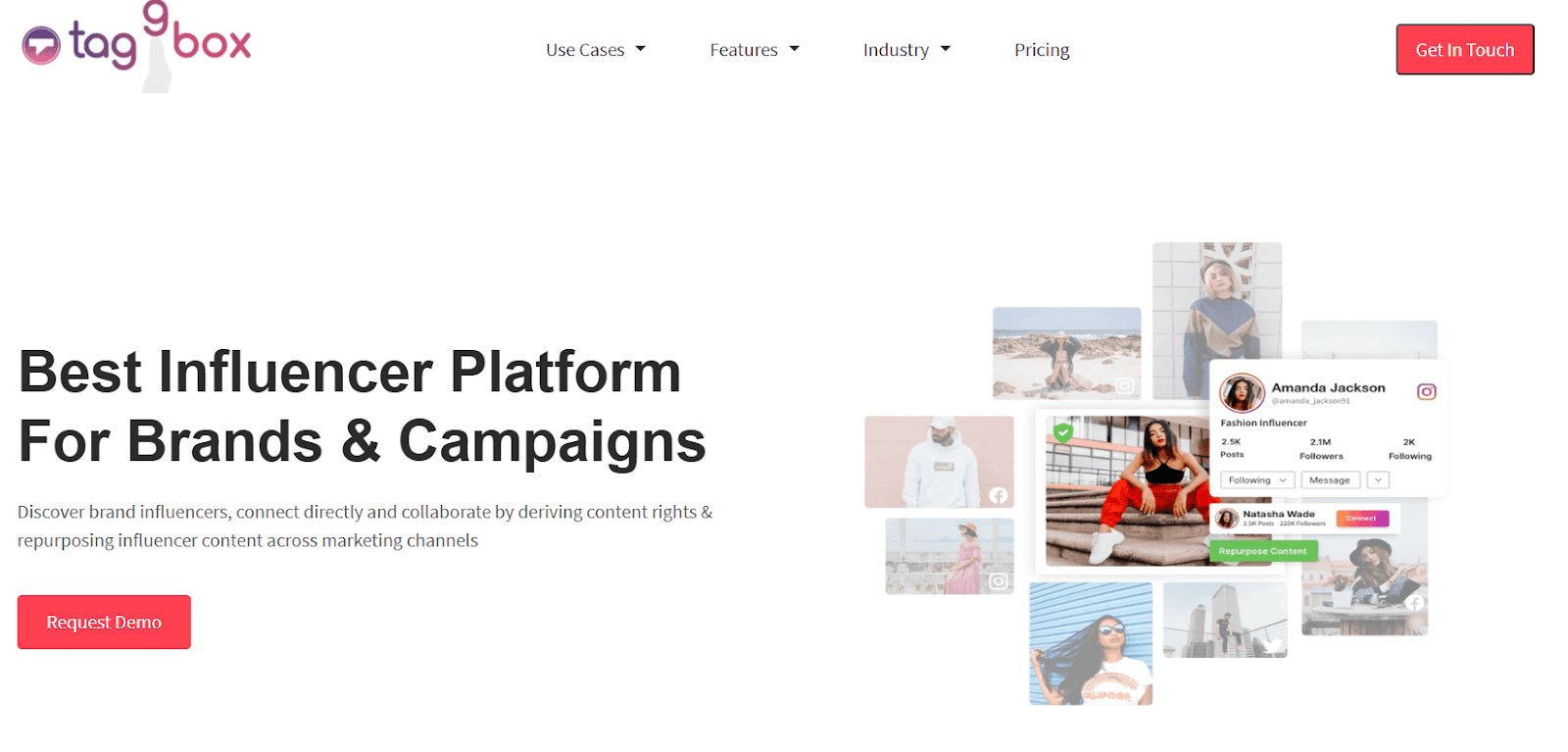
Best For: Taggbox is best for brands and agencies that want to aggregate, curate, and repurpose user-generated content (UGC) across websites, events, and marketing campaigns. It’s especially useful for eCommerce, hospitality, and lifestyle brands looking to showcase authentic social proof and enhance brand trust.
Platform Coverage:
Pricing: Taggbox offers four main subscription plans, each with higher feed limits, faster content updates, and expanded moderation tools.
Review: 4.8 / 5.0 (G2)
Ease of Use (UX/UI): Users often highlight Taggbox’s straightforward and intuitive interface, which makes it easy to curate and embed UGC without technical expertise. The drag-and-drop style widgets and flexible design templates simplify setup, enabling marketers to quickly launch interactive content displays across websites, eCommerce stores, and events.
Customer Support: Taggbox is praised for its responsive and dedicated support team, available via chat and email. Users mention that onboarding is smooth thanks to detailed guides and fast troubleshooting assistance. Premium accounts often receive priority support, ensuring campaigns run seamlessly even at scale.
While TRIBE is a creator marketplace focused on influencer campaigns and scalable creator-led content, Taggbox is designed primarily for UGC aggregation, social proof, and event marketing. TRIBE’s strength lies in connecting brands with a vast network of 70,000+ creators and offering campaign management tools with AI-driven discovery, whereas Taggbox excels at curating UGC from across multiple platforms and turning it into engaging, shoppable, and rights-cleared content displays.
From a pricing standpoint, TRIBE operates on a campaign activation fee plus a 30% platform margin (or annual agreements with tailored pricing). Taggbox, on the other hand, offers subscription-based pricing with feature tiers—making it potentially more cost-efficient for ongoing content aggregation, while TRIBE may be better suited for brands with higher budgets and campaign-focused influencer strategies.
Users should choose TRIBE if their priority is influencer discovery, campaign execution, and large-scale creator partnerships, while Taggbox is the stronger choice for brands seeking to enhance eCommerce conversions, event engagement, and UGC-driven brand trust.
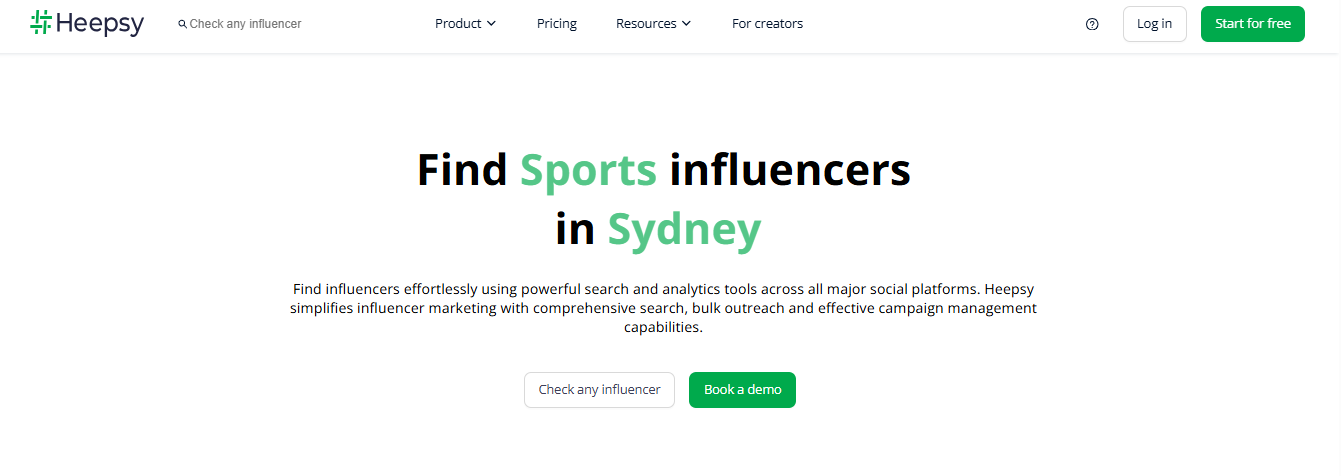
Best For: Heepsy is best for eCommerce and DTC teams that want a straightforward, cost-efficient way to run influencer discovery, bulk email outreach, and campaign tracking—adding Shopify/WooCommerce sales attribution on the Advanced plan when affiliate revenue matters.
Platform coverage:
Pricing & Commitment: There are different plans:
Reviews: 4.5 / 5 (G2)
Ease of Use (UX/UI): Heepsy’s multi-filter search (keywords, demographics, engagement, authenticity) makes it quick to build precise shortlists. Lists feed into a kanban-style CRM to track stages like emailed, approved, shipped, sales, and paid, while a media gallery centralizes content and metrics. Bulk outreach (with templates and follow-ups) reduces manual steps, though templates are not AI-generated.
Customer Support: The pack highlights onboarding calls, template guidance, and responsive customer support. Seasonal offers and flexible plan changes (upgrade/downgrade/cancel) are called out, which is helpful for teams piloting or scaling.
TRIBE is an opt-in creator marketplace—brands post briefs and receive creator pitches; TRIBE then handles payments, legal, approvals, and can license content or convert it to paid ads. Heepsy is a software-led discovery/outreach CRM: teams build lists with granular filters, run bulk email, track stages in kanban, and (on Advanced) connect Shopify/WooCommerce to attribute sales. Choose TRIBE for pitch-driven content production with built-in approval/payments; choose Heepsy to own discovery and outreach in-house with light CRM and optional commerce attribution.
TRIBE operates with activation fees + platform margins on creator spend (and tailored annual agreements). Heepsy offers monthly plans and seasonal discounts on 6-month/annual terms; the Advanced plan was quoted at $369/month (with examples of 35% yearly and 20% semi-annual promotions). For teams seeking predictable, lower fixed SaaS costs and full control of outreach, Heepsy is attractive; for campaign-by-campaign production with managed operations, TRIBE’s marketplace model can fit better.
If success hinges on rapid pitches and turnkey approvals/payments, TRIBE’s end-to-end marketplace motion reduces operational lift. If success hinges on scaling search + email at volume and attributing orders/revenue via your store stack, Heepsy’s Advanced (Shopify/WooCommerce) path provides a leaner, self-operated alternative.
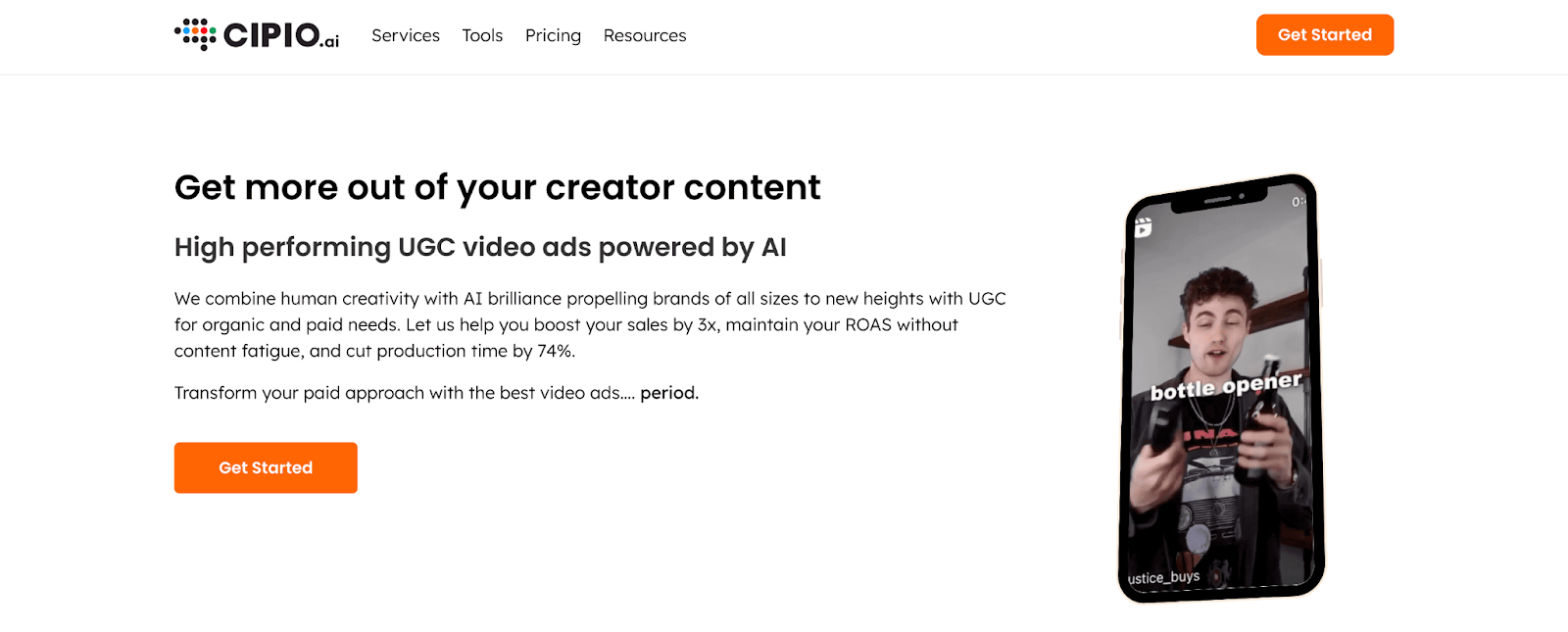
Best For: Cipio is best for eCommerce and consumer brands that want to turn their customers into influencers, scale UGC-driven marketing campaigns, and leverage ambassador and loyalty programs to drive ROI. It’s particularly valuable for brands looking to unify influencer discovery, UGC rights management, and customer advocacy in one platform.
Platform Coverage:
Pricing: Cipio offers three flexible pricing models.
Pay-As-You-Go:
(No contract required; billed monthly based on usage.)
Quarterly Plan (min. 15 creators & 18 ads):
Annual Plan (min. 60 creators & 72 ads):
Reviews: 4.9 / 5.0 (Glassdoor)
Ease of Use (UX/UI): Users describe Cipio as intuitive and easy to navigate, with dashboards that make tracking creators, UGC, and campaign performance straightforward. Many users highlight that it feels like an “all-in-one” hub for ambassador programs, reducing the need for multiple tools.
Customer Support: Cipio receives strong feedback for its hands-on support. Brands mention that the team is proactive in onboarding and ensuring campaigns are set up correctly from day one. Support is often described as “collaborative,” with account managers helping brands with strategic recommendations beyond just platform troubleshooting.
TRIBE focuses on scale and marketplace variety, giving brands access to 70,000+ opt-in creators across platforms like TikTok, Instagram, and Pinterest. It’s ideal for brands wanting to quickly launch influencer campaigns with a wide range of pre-vetted creators. Pricing is typically structured around campaign activation fees and platform margins, with a 30% markup on creator spend. This makes it well-suited for brands running frequent, trend-driven campaigns, but the costs can add up for smaller budgets.
Cipio, on the other hand, is more about depth and advocacy-driven strategies. Instead of just renting access to creators, Cipio empowers brands to build long-term programs that engage existing customers, ambassadors, and influencers in a unified platform. Its strengths are UGC rights management, ambassador loyalty programs, and direct attribution of influencer sales. Pricing is more predictable and ROI-driven, making it attractive for brands focused on long-term growth rather than one-off campaigns.
When comparing TRIBE to other influencer marketing platforms, it’s clear that each solution offers unique strengths depending on your brand’s goals. Platforms like Cipio and Taggbox shine in building long-term ambassador programs and leveraging UGC, while CreatorIQ and Upfluence stand out with enterprise-grade reporting and discovery tools. For brands focused on quick access to a large pool of creators, TRIBE remains a solid option—but it often comes with higher costs and less emphasis on sustainable, long-term ROI.
If you’re looking for the best all-in-one alternative, Influencer Hero stands out as the top choice. With robust discovery, CRM, UGC rights management, affiliate tracking, and campaign analytics all in one platform, it offers the versatility brands need to scale efficiently. Ready to see how it can work for your business? Book a demo with Influencer Hero today and take your influencer marketing strategy to the next level!

A marketplace such as TRIBE revolves around briefs and pitches: you post what you need, creators submit ideas, and you approve and purchase the content you like. Full SaaS platforms—think Influencer Hero, Upfluence, CreatorIQ, GRIN, or HypeAuditor—hand you the operational controls to run always-on programs: discovery, outreach, CRM, contracts, reporting, and revenue attribution. If your goal is rapid content with minimal process overhead, a marketplace is often the fastest path; if you need relationship ownership, performance tracking, and repeatable workflows at scale, a SaaS platform is usually the better fit.
Start by exporting everything you’ve approved—assets, usage rights, captions, deadlines—and mirror those requirements in the new platform’s brief and pipeline structure. Recreate tracking (UTMs, discount codes, and store or analytics integrations), then run a short overlap period where a final TRIBE campaign continues while you test outreach and attribution in the new tool, such as Influencer Hero. Before fully switching, confirm that the destination platform supports data import, creator deduplication, e-signature, payouts, and the reporting granularity your stakeholders expect.
Platforms built around commerce tend to lead here. Influencer Hero offers an end-to-end flow from discovery and outreach to gifting, links/codes, and ROI dashboards that tie creators to revenue. Upfluence and GRIN go deep on store integrations, commissions, and payouts, while HypeAuditor combines discovery with Shopify and payment connections for order-level reporting. When evaluating, prioritize native links/codes, order sync, and payout automation so sales can be attributed cleanly to creator efforts.
In marketplaces, rights are typically purchased per asset at the point of approval, often with time or channel limits and straightforward options to license the content for paid media. SaaS platforms manage licensing inside briefs and contracts, track expirations, and let you flag which assets are cleared for whitelisting or Spark Ads, creating an audit trail across campaigns. Whichever route you choose, verify that contract templates, renewal reminders, and paid-media permissions are built into the workflow so legal and media teams aren’t managing these details in spreadsheets.
Expect three common models. Marketplace spend is tied to campaigns—activation fees plus a margin on creator payments—so costs flex with each brief. SaaS platforms charge a subscription (monthly or annual) with usage tiers; Influencer Hero is popular with teams that want predictable software costs while owning the day-to-day operations. A third path is managed service, where a vendor handles sourcing and outreach for a fixed retainer; this suits lean teams that need output without adding headcount. Align the model to how you plan and fund work: campaign budgets often map to marketplaces, program budgets to SaaS, and bandwidth constraints to managed services.



Schedule a Demo with one of our media experts below.